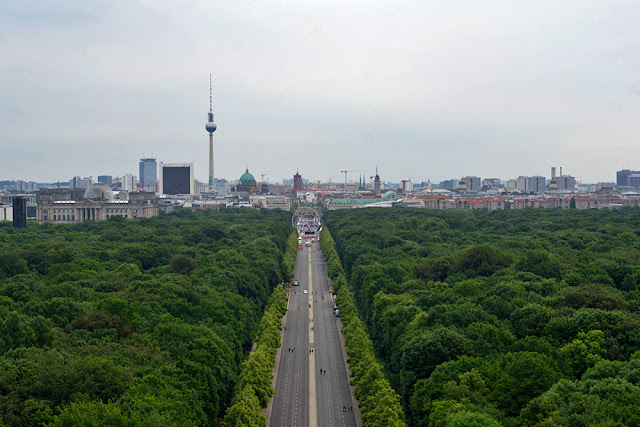 |
Oddly satisfying aspects continued- when your drink matches the colour
palette of your city guide. The shot was taken in the café of C/O Berlin, a
cultural foundation which organises photo exhibitions in the building of the
Amerika Haus, which until 2006 had housed the information centre of the US
Embassy.
|
 |
Potsdamer Platz is another typical Berlin destination in that the context
is much more important than what you actually get- which is a lot of glass high
rises, a slightly confusing transfer hub to suburban rail lines, the Sony centre with people munching sausages before going to the cinema- incidentally,
the Berlin film festival has its most important venues in this area, plus
further bits of the wall. Between the two world wars, the square had been one
of the busiest intersections in Europe and an iconic centre to the city’s
nightlife, akin to London’s Piccadilly Circus. It was then almost entirely destroyed during the WWII air raids, and became basically deserted when the
wall cut it into two. Potsdamer Platz was also the stage of Roger Water’s
monumental rendering of The Wall in July 1990. It’s rundown version is also
featured in my pet Berlin love, you guessed right- Der Himmel über Berlin.
|
 |
Rats as graffiti are of course super popular, especially since they were
widely used by Banksy. Their origins can however be dated back to French artist
Blek Le Rat, who started stenciling them in Paris in the eighties, and described them as "the only free
animal in the city". The mum or dad of this Berlin rat is unknown, but
there are other rodents populating the city as well, such as those drawn by Belgian artist Roa.
|
 |
| Because cats with (sun)glasses are very much a thing everywhere. As I was saying. |
 |
The banks of the Spree bring me to another literary Berlin of mine, the one
in Mateiu Caragiale’s novella Remember. Of which there seems to be no proper
English translation- I’d always harboured this half defined thought that you
can’t really translate Mateiu Caragiale’s work, because it’s so idiosyncratically Romanian and sure enough, I found an article on the subject. In which the
author at least manages to give a pretty accurate definition of Caragiale’s
creation, "a melancholy, reptilian world, lavishly ornamented in
language. " And some of this world is spread along the
waters of the Spree.
|
 |
One of those fortuitous instances of mutt looking quite a lot like their
owner. Cats of course never look like their owners- that only ever occurs the
other way round.
|
 |
| Home is where you can match all the stops on the metro with the landscape above, in foreign cities you’re travelling in a pleasant cocoon of alien sounding surprises to be. |
 |
| But even new cities become a little bit yours when you start having places you feel like going back to, so I could not resist temptation and returned for a coffee to Westberlin. |
 |
| The person who took the most expensive photograph in the world, Andreas Gursky, is incidentally German, what’s more, East German, and the incriminated shot is a rather innocuous landscape depicting the Rhein river. I leave you to be the judges of what that’s all about, until then I’ll practice my minimal skills on the German countryside as well, and hope for the best. |
 |
Max Liebermann was one of the most important representatives of German
impressionism, and from 1909 he spent a lot of time in his Wannsee villa,
painting many lakeside scenes, gardens and beer gardens on the way. I am
particularly fond of the idea of the beer garden as a romanticized locus of idle
happiness- all those decadent Paris bars of Impressionism are grand all, but
they’d probably be unable to serve you
with a decent pint which is frankly unpardonable. The villa is today a foundation and a museum
open to visitors around the year.
|













No comments:
Post a Comment